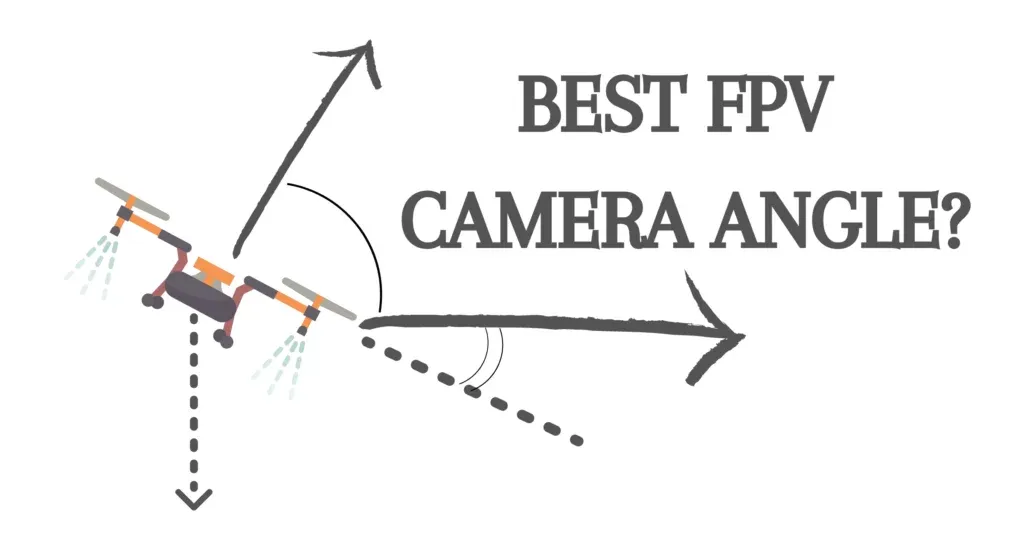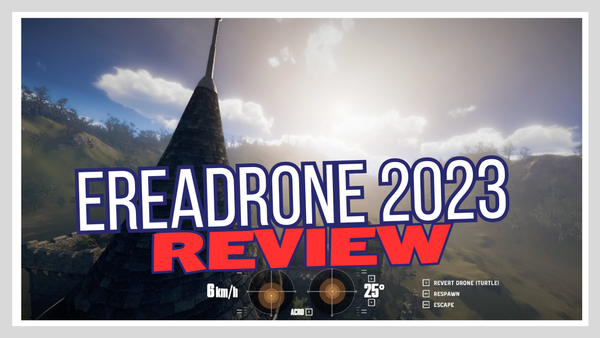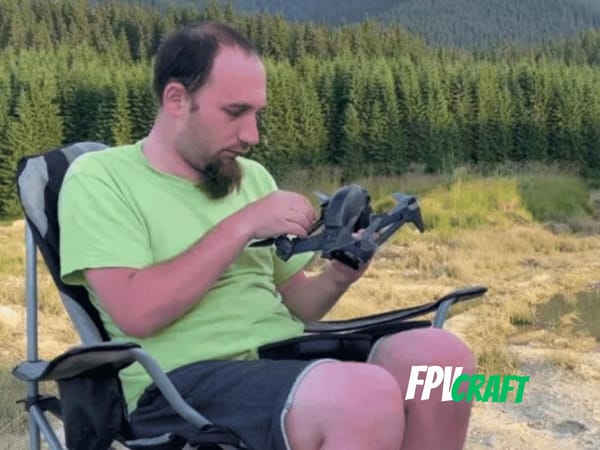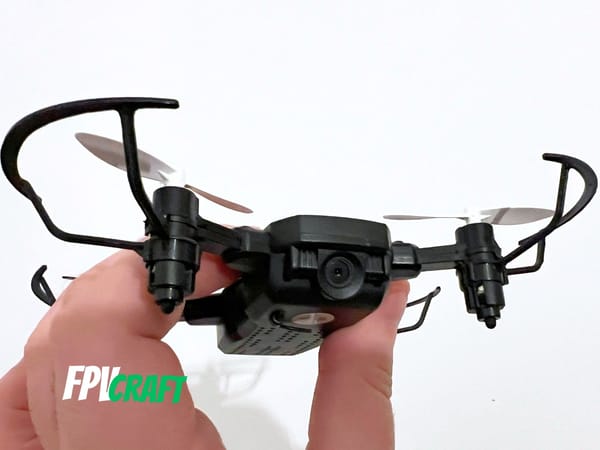What Is the Best FPV Camera Angle?
Every FPV drone must have a camera angle set at a specific degree to fly at certain speeds. What is the best one to use?

The camera angle of an FPV drone directly impacts how fast the FPV drone can fly. In order to fly forward, your FPV camera drone has to be set at a specific angle upwards to have a reference point: the horizon line.
The higher the camera degree on your FPV drone, the faster the drone will fly, following the horizon line as a reference point in the middle of the screen. But, in reality, what is the best camera angle you can set for your FPV drone?
Does it really depend on many factors, such as what you will use your drone for? Racing, freestyle? Fast or slow cinematic FPV? Indoors flight? Or simple free flights? YES!
Please note that the DJI FPV camera angle is more affected by speed flights, and I usually set the DJI FPV drone with about 10 degrees less than a traditional FPV drone for the same or similar flight results due to motor power, size, and its own aerodynamics.
In the meantime, I am going to give you an answer paragraph if you are only looking for a quick answer:
What is the best camera angle to fly your FPV drone?
- Racing: 45 degrees
- Freestyle: 25-30 degrees
- Fast cinematic FPV (cruising): 35 degrees or more
- Slow cinematic FPV (cinewhoop): 15 degrees or less
- Indoor flights (cinewhoop): 5 to 10 degrees
- Free flights: 10-30 degrees
- Experimental: 0 degrees
To paraphrase this, there is no “rule” to use the exact camera angle degree for your FPV drone, as stated above.
Depending on many other factors, you need to set it somewhere around the values for the best results. Whatever value you set, practice it to improve your skills, as different camera angles may result in foreign control sensitivities in yaw, pitch, roll, and throttle.
For instance, some drones can gain higher speeds and different controls at the same camera angle compared to other FPV drones. The factors below may affect those values.
What is the experimental flight? It is a type of flight (renamed by me) I love to undertake while flying FPV at a specific 0-degree camera angle. This will allow you to control the FPV drone smoothly in all directions, but with higher sensitivity, and combine multiple types of flights, where observing the horizon line below the mid-screen will always let you move the aircraft forward at a specific controllable speed.
I will try to cover an entire article about flying at 0 degrees and why I consider it to be an experimental FPV flight.
What factors can affect the FPV drone speed at a specific camera angle?
When we have to set the camera at a specific angle for different types of flights, this may not always respond as we like.
For instance, a micro drone or 3-inch quad will respond differently if you set it at 30 degrees than a 5-inch quad.
The 5-inch quad has more power, is heavier, and will fly faster, perform sharper maneuvers, etc.
But depending on the field of view, you will see more or less the same thing through your goggles, the horizon level will be positioned the same, and the controls should respond similarly.
» READ MORE: Best Gain & Expo Rates for DJI FPV Drone
The camera field of view
The camera field of view is a factor affecting your FPV drone speed at a specific camera angle. The lens field of view is reflected in the camera’s lens aperture.
A higher camera focal length (e.g., 3.0mm – which gives you roughly 110-120 degrees field of view) is set to be more sensitive to observe as gaining speed and maintaining a horizon level than a lower camera aperture (e.g., 2.1mm with 150-160 degrees field of view).
Although the field of view does not directly impact the drone’s speed as the camera angle, it does have an impact in keeping the drone stabilized at specific rates on that angle, which was a consequence of your flight style and maintaining the correct speed.
For example, it’s easier to maintain a constant speed with a 110-degree field of view, and at the same time, more challenging to keep the horizon level as the image you see through your goggles is “more magnified.”
A wider field of view (such as 150 degrees, for example) gives you more room to observe the surroundings.
However, due to a wide field of view, it is often perceived to fly at a lower speed than a narrower field of view, but in reality, the flight speed is roughly the same.
Motors power of an FPV drone
While flying at a higher degree angle (fast), an FPV drone’s motor powers directly affect gaining higher speeds. The higher the angle and the more powerful the drone motors are = the higher the speed.
It is to know that also, the more powerful the drone motors are, the more difficult it is to maintain the stability of the drone at lower speeds. Your throttle input will be more sensitive in this case.
That’s why even larger cinewhoop drones have weaker motors (for instance, DJI Avata) to help with stability at slower speeds.
Alternatively, you can limit the max throttle in Betaflight if you feel that your drone motors are too powerful, but that shouldn’t make any difference on the actual flight, but to the max throttle.
Microdrones have weak motors as the drone is small in form factor. That’s why you can fly microdrones indoors, but you will find difficulties even controlling large drones with big thrust outdoors.
The aerodynamics and the weight of a drone
How a drone is constructed reflects on aerodynamics, which directly influences on having a specific flight speed at one particular camera angle.
I can give you a good example, and although other factors may contribute here, the DJI FPV drone is way faster than a traditional drone at, let’s say, 20 degrees angle, while with some other drones, at 20 degrees angle, you may have a smooth lower speed flight.
According to DJI.com, 0-10 degrees is slow flying, 11-20 degrees is fast flying, and 21-45 degrees is extreme flying.
In this case, the 20-degree camera angle on a DJI FPV drone is the barrier between fast and extreme flight speed, while to some other FPV drones, it classifies at medium flight speeds.
You may also concur that the main factors contributing to such a difference in speed at the same camera angle between a classic FPV drone and the DJI FPV drone are the aerodynamics, weight of the drone, and the motors’ power.
The drone’s weight directly impacts flight time, acceleration, and maneuverability, affecting its agility and overall flight speed, particularly if we consider it a constant.
» READ MORE: What is the Best DJI Avata Camera Angle?
Your flight style and the horizon line position
Of course, those two factors have a massive impact on the FPV drone’s speed flying at a specific camera angle.
When you maintain a stable flight such as cruising, you keep a steady speed that can be lower or higher than what you can reach at a specific camera angle due to less maneuverability required and the current horizon line position.
To give you a more complex example of another flight style, but hectic, if you often pitch and adjust the horizon line up and down, the drone tends to accelerate and brake; however, the acceleration is generally at a higher rate than the breaking speed when you apply the gravity as a factor in some situations like diving or flying down a valley, which concludes in resulting from reaching higher speeds of the drone of a specific camera angle.
- Now, what about the horizon line position?
The horizon level is the absolute main decisive factor in concluding the speed of your FPV drone at a specific camera angle.
If, for example, your FPV camera angle is set at 20 degrees, you gain a specific speed while maintaining the horizon level in the middle of the screen (standard). If you pitch forward and the horizon level line goes up, the drone gains speed (accelerates).
Maintaining a horizon level line above the middle of the screen from your FPV goggles is the same as flying your FPV with a camera set to a higher angle but having the horizon level line in the middle of the screen.
This goes the opposite way; if you decelerate and maintain the horizon level line below the middle of the screen, your FPV drone is slower, reflecting equally at the same as having a lower camera angle whilst the horizon line is in the middle of the screen.
As an update to the article, I love to have free flights with my FPV drones that are not to be considered freestyle – simply enjoy the flights with fewer risks, and I always found that around a 15-degree camera angle to be the sweet spot for me, which I tend to fly the most and 25 for freestyle.
» READ MORE: 27 FPV Tips to Know Before Flying FPV Drones
Controllable free-falls
When your FPV drone is in free fall, and you align the direction correctly, the drone accelerates towards the ground, affected by gravity, which reflects on the drone’s weight.
The heavier the drone is, the harder it accelerates, and at the same time, the more difficult it is to stabilize it from the free fall.
Depending on your camera angle, the drone can be affected differently by its aerodynamics in free fall. Even after stabilizing it, the initial momentum gave the drone more speed than it naturally supports at your fixed camera angle.
Weather conditions
That would be another factor, simple to understand. Are you flying against the wind or with the wind? Is there no wind at all? The wind has a direct impact on the speed of your drone.
» Related: DJI FPV Wind Resistance (explained)
A humble conclusion
Mother physics teaches us that all those values and constants impact the flying speed of a drone at a specific angle.
As for setting the camera angle for your flight style, you must consider factors such as the weight of the drone, the aerodynamics, the motor’s strength, and your overall comfortable flight style.
Once more, those are not standard rules; they are merely guidelines. However, those are generally some common values most FPV drone pilots use.
Play safely with those settings and adjust them accordingly per your liking. In the end, for our safety, please have a look at our safety warnings policy
What is the Best Liftoff Simulator Camera Angle to Learn FPV




